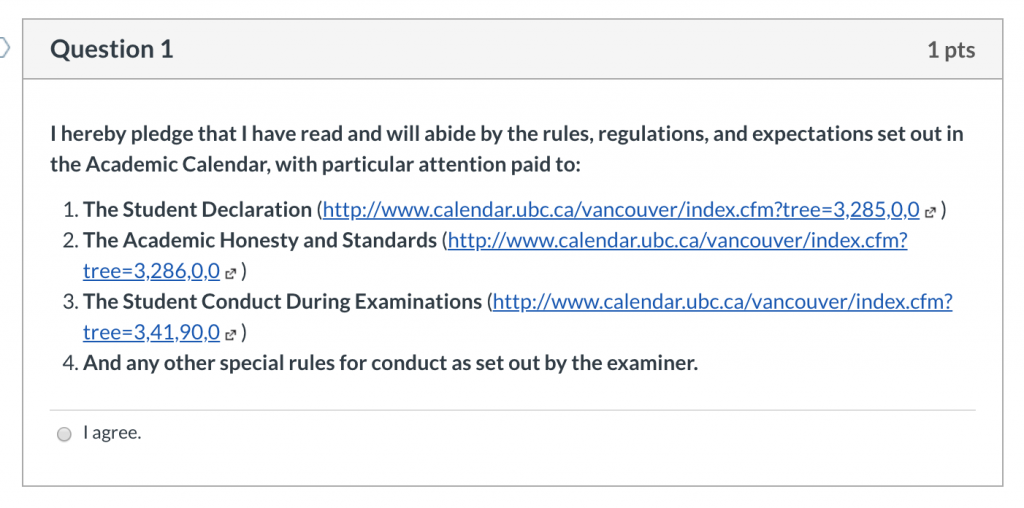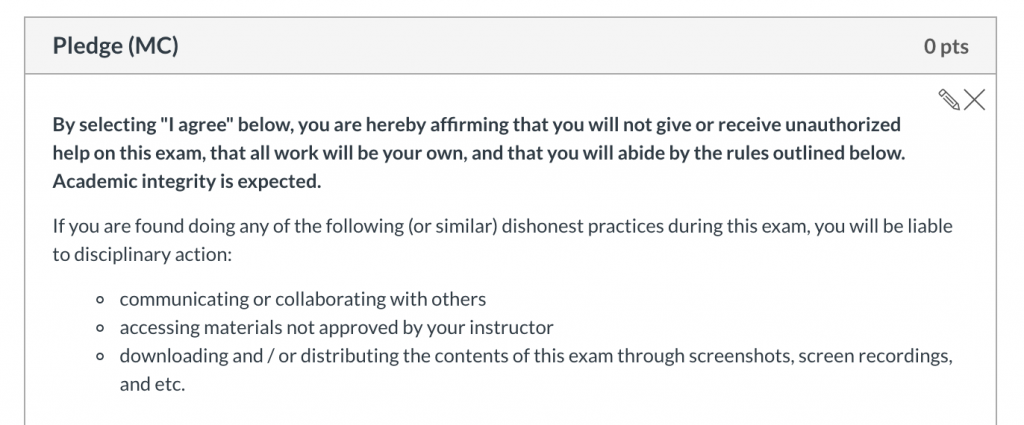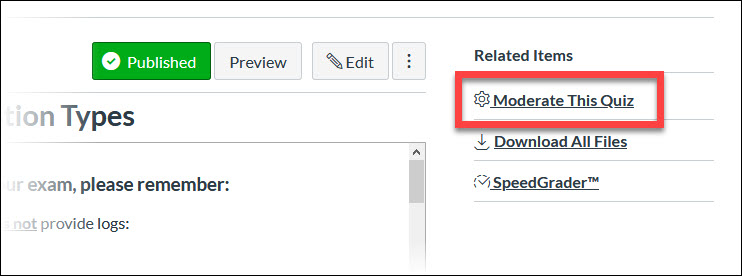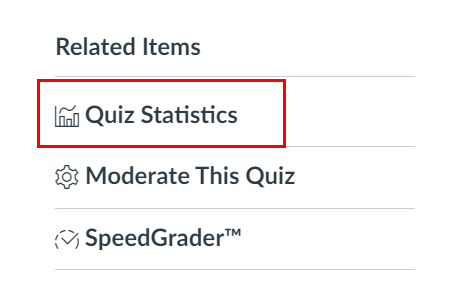Publication Status:
- Draft
- Ready for Approval
- Approved
Midterm and Final Exams
Exams are used as high-stakes summative assessments. There are a number of strategies and tools that are used for exams.
Canvas Exam Integrity Measures
- Randomization: Randomizing the order of questions can prevent students from collaborating.
- Single Question Display: Displaying questions one at a time can discourage students from taking screenshots, downloading, and printing entire exams for sharing elsewhere.
- Question Banks: The use of question bank groupings of question types, where Canvas then selects individual questions for individual students, can prevent collaborations on exams.
- Timer: Timed exams can ensure that students have enough time to recall responses, but enough time to look up answers or collaborate with each other.
- Exam Design: Various exam designs can help prevent academic integrity issues in individual circumstances.
- Question Types: Create the exam with question types designed for integrity. Instructors should be familiar with what kind of question types are available. Review the question types and how to answer them.
Lockdown Browser
Lockdown Browser is a web browser that “locks down” what students can do during a quiz in Canvas. When students use LockDown Browser to take a quiz, they will be unable to print or copy questions, visit other websites, access other applications, or close the quiz until it is submitted. Quizzes created for use with LockDown Browser cannot be accessed with standard browsers.
You can use LockDown Browser to help preserve academic integrity in Canvas quizzes and exams:
- Restricting what students can do in their main browser (e.g., no printing, copying, accessing other websites)
- Locking down in-person assessments, along with in-person invigilation
- Locking down online assessments, along with web-conferencing invigilation
- Sharing exam results and feedback with students in a locked-down environment
We do not recommend using LockDown Browser with Zoom. The tools were not designed to be used in coordination, and combining them can trigger challenging technical issues for a significant number of students. You can read more about our recommendation against using Zoom with LockDown Browser for invigilation for additional information.
Lockdown Browser does not work well with assessments that:
- are open book
- require students to upload file(s) or photo(s)
- contain a lot of images – if an image breaks, there is no way for students to right-click to open the image in a new tab
- require Excel and the use of formulas – Lockdown Browser’s version of Excel has limited capabilities
(source: https://lthub.ubc.ca/guides/lockdown-browser-instructor-guide/)
Turnitin
Turnitin is a plagiarism prevention tool that helps you check the originality of student writing. Turnitin generates a similarity score for each student, which can be used to assess how original their work is. You can also use Turnitin to provide marks and detailed feedback for each student and re-use common feedback across multiple student submissions. Students may use it to check their work to avoid accidental plagiarism before submission.
Sauder Learning Services has modified Turnitin software that turns each student’s response into a PDF. A folder containing all students’ PDFs will be provided to the instructor for uploading to Turnitin. In this way, instructors may use such a folder to check for submission similarities between students.
Integrity Pledge
Learning Services will copy an Integrity Pledge into a course several days before the actual exam date (if not earlier). There is also a Tech Check course available for students to self-enroll. This tech check course is intended to:
- Familiarize students with the “exam experience”
- Help students identify any technical issues that may arise during their actual exam
- Ask students to agree to the following integrity pledge:

Learning Services also adds a shorter integrity pledge to the beginning of each exam:

Instructors can use this Canvas announcement template to encourage students to self-enroll in the tech check course prior to the exam.
Before the Exam
Exam Preparation, Build, Configuration, and Access
To assist instructors in preparing for an exam, here are some resources to show them how to:
1. Prepare for an online exam
• Technical Checks — Instructors and students can self-enroll in the “UBC Sauder Exam Tech Check Course” to identify any technical problems prior to the exam. This course informs students on what to expect when writing a Canvas-based exam and includes an “Integrity Pledge and Tech Check” quiz that will mimic an exam’s settings and question types, ensuring that students become familiar with the experience.
• Exam Rooms — The Undergraduate Office will be facilitating the booking of exam rooms and hiring of Invigilators. Please email ugooperations@sauder.ubc.ca to begin the process.
2. Build the exam
Learning Services requires 10 business days of lead time to help an instructor build an exam. Requests may be made by emailing help@sauder.ubc.ca
If they would like to self-serve, here are some resources:
- UBC’s Keep Teaching Website – Assessments
- Canvas Instructor Guide — Building Quizzes
- To see an example of a Canvas quiz and the question types, see Canvas Quizzes – Available Question Types
- Want to hear from your colleagues on their tips + tricks for building online exams? Consider watching these faculty round-table webinars on designing online exams:
- Using Canvas Question Banks
- Question Banks can be used to randomize question orders. Instructors can also use them to pick from a pool of questions to create different versions of an exam for each student.
- Upload quiz questions via Respondus Quiz
- Respondus Quiz is a software that allows instructors to compile exam questions in a word document. These can be uploaded all at once directly into a Canvas quiz or question bank.
- Using Respondus to upload multiple choice questions is much faster than doing it manually in Canvas!
- Respondus also allows instructors to import publisher question banks. Instructors should contact the publisher directly if they would like to import publisher questions. More details are available on the Respondus below.
- Have a formula sheet or long content to embed in exams? Consider this toggle button solution. If there is a formula sheet to embed, consider typing the formulas in LaTeX syntax.
- Review guidelines for building online assessments to minimize Academic Misconduct.
- Convert a Canvas Quiz to a printable PDF for paper exams.
Even if the instructor is building their own exam, Learning Services will add an integrity pledge to the exam. Exam-saving reminders will also be added that guide students on how to check if their answers are saving in real time during the exam. In order for Learning Services to know when to add these components, contact help@sauder.ubc.ca to let us know that your exam is ready for them.
3. Configure the settings
The following Canvas quiz settings are recommended — Learning Services will review every exam and configure accordingly. If an instructor is taking care of their own exam, these might be helpful guidelines as well.
- Include the term and date in the exam title (e.g. 2021W2 COMM 333 Final Exam – April 2, 2022).
- Clarify in the instructions what students are and aren’t allowed to use in their exams.
- Set the time limit as the exact exam time (i.e. a two-hour exam will be 120 minutes)
- Do not check the boxes:
- “Allow Multiple Attempts”
- “Let Students See Their Quiz Responses (Incorrect Questions Will Be Marked in Student Feedback)”
- Once the exam is published, ensure that its column in “Grades” is set to manual — this will ensure that students do not see their marks immediately upon submitting the exam.
4. Give students access to the exam
Upon publishing, a Canvas quiz is assigned to “Everyone” in the course by default.
Instructors can configure the exam to be assigned to different students at different times/dates — i.e. one section in the morning, the other section in the afternoon.
To set up exam times and dates:
- Leave the due date blank.
- Set the “Available from” to be the exact time/date when the exam is scheduled to start.
- Set the “Available until” time to be 1 hour after the exam is supposed to end. This gives Learning Services a “cushion” to extend student timers in case they run into any technical difficulties — please note that students will still be restricted to the time limit.
- Use the +Add button to configure other sittings.
Once again, Learning Services is happy to review all of these settings as well!
Adjusting student attempts and time during an exam
Besides configuring the availability, instructors may also need to extend the time allowed per exam attempt or add an extra attempt.
Centre for Accessibility Student Access
The steps above must be done for CFA students as well, since they are allowed extra time. In addition, if you are using Lockdown Browser on your exam, the CFA have requested instructors to log into their account on the CFA Website and under additional information space for the CFA students, input the Proctor Exit code for the exam season. This is the code that the invigilators use to exit Lockdown Browser during an exam to troubleshoot technical issues. A member of the Learning Services team will reach out to disclose this proctor exit code for you to enter in the CFA website. Please include in the instructions that the code is for invigilator-use only. This extra step is only applicable for Lock-Down browser exams.
Best Practices for Delivering Online Tests and Quizzes
Tips for Instructors
- Offer a Practice Test:
- Include the same question types that will be asked on a real exam.
- Use similar settings to those that will be used on a real exam, e.g., timed tests vs. un-timed tests, multiple vs. single attempts, use of Lockdown Browser
- Ensure the students complete the practice test as close to the exam date as possible so they have the most up-to-date software for the exam.
- Send a follow-up email to all students who have not completed the practice test a day before the exam (this can be done through the Canvas Gradebook).
- Use similar settings in quizzes that will be used in the midterm(s) or final so students are familiar and comfortable with the online exams and settings.
- Request a review of the settings before the exam is published (help@sauder.ubc.ca).
Tips for Students
- Before the exam, remind students to:
- Verify they have a stable network connection before starting the exam. Get students to connect to UBCSecure (or UBCVisitor if UBCSecure is not working)
- Set their phones and other WiFi-enabled devices to airplane mode to minimize load on the wireless network.
- Use only supported browsers: https://community.canvaslms.com/t5/Canvas-Basics-Guide/What-are-the-browser-and-computer-requirements-for-Canvas/ta-p/66
- Shut down all other applications & activities on their computer.
- Disable third-party browser security add-ons or applications.
- Don’t use the browser’s Back or Forward buttons to navigate an online exam.
- Preferably don’t use mobile devices to take the exam.
- Keep checking whether their answers are saving.
- Read all instructions and questions carefully.
- Don’t forget to submit the exam when finished!
Adapted from:
- Best Practices for Delivering Online Tests & Quizzes
- Essential Tips for Taking Online Tests
- CTLT Online Teaching Program – Module 3: Designing Online Assessment
UBC Resources on Online Assessments
- CTLT Online Teaching Program – Module 3: Designing Online Assessment
- This module addresses how to plan, design and develop assessments in online courses. It also explores providing feedback online, involving students in the assessment process, rubrics, and how to encourage academic integrity in online assessments.
- Reimagining Assessments – This is a Wiki page intended to be an open resource for instructors who need to move from traditional face-to-face assessment to online assessments. The resources explores opportunities, benefits and online challenges for several assessment types.
- Creating Multiple Choice Questions for Higher Order Learning – resources from CTLT workshop (slides and recording)
- Building Authentic Assessment for Online Learning – resources from CTLT workshop (slides and recording)
- Alternatives to In-Person Exams (UBC – CTLT)
Other Recommended Resources
• Online Assessment in Higher Education guide from the University of Calgary
“This guide aims to provide an evidence-based background on the prevalence, benefits, challenges and importance of online student assessment in higher education. Outline strategies and recommendations from research and practice that can be used to mitigate challenges of assessing students online. Encourage instructors to thoughtfully design student assessments for use in online courses.”
• Designing Online Assessments module from the University of Calgary.
“This online module provides useful information about how to implement different types of assessments that are aligned to course learning outcomes.”
• Alternatives to Traditional Testing from the Center for Teaching & Learning at UC Berkeley
• Alternatives to Traditional Exams and Papers from the Center for Innovative Teaching and Learning at Indiana University Bloomington
• Designing Effective Online Assessments from the National University Singapore
• Encouraging academic integrity in remote, online, and in-person learning contexts from the Centre for Teaching Excellence, University of Waterloo.
Respondus – Quiz Authoring Software

Respondus Quiz is an assessment software for quickly creating quizzes that can be imported to a Canvas course.
Instructors can use Respondus to create Canvas quizzes by uploading Word/text documents as well as publisher questions from the Test Bank Network.
1. Download and install Respondus
Instructors who have not used Respondus Quiz can download it using the following steps:
- Go to the: Software Distribution site, and sign in with their CWL.
- Select “Respondus Quiz” from the Faculty tab.
- Click “Add to Cart”, then “Check Out.”
- Follow the prompts until they reach an Order Summary screen with a download link.
Instructors should take note of the following when they appear during the download process – this information will be needed during installation:
- Institution Name: University of British Columbia
- Local Support Contact(s): lt.hub@ubc.ca
- Installation Password
Note that the authoring software currently only works on the Windows platform.
2. Create quiz banks and Canvas quizzes
- Preparing Exam Questions for Import into Respondus
- Importing Questions into Respondus
- Publishing Questions into Canvas
- Creating Canvas Quiz questions from a publisher using the Test Bank Network. (Requires a registration code and password sent by the publisher.)
- Respondus – Video Tutorials
- Respondus – Instructor Quick Start Guide
- Respondus – User Guide for Canvas (full guide)
- Respondus Knowledgebase
If the instructor encounters any issues with Respondus, please email help@sauder.ubc.ca.
During the Exam
Once the exam is built and the logistics are prepared, students will be assigned to a classroom and required to bring their own device, usually their laptop, to write the exam. The instructor is expected to be on-site during the exam.
This video summarizes what instructors can expect during an exam.
In-Person Canvas Exam Support
Instructors must be in attendance during exams. Learning Services will provide live technical support.
Please note that Learning Services does not currently have the capacity to provide live support for take-home exams, assignments, or Centre for Accessibility students who are writing outside of the main exam sitting. Support for alternate exams is available if:
• Exam is no longer than 3.5 hours
• 10 or more students are writing the same exam
• Exam is scheduled to begin and end between 8am and 10pm PST
• Instructor is on-site
Please note that only 1 alternate exam per course will be supported.
1. What to Expect
30 minutes prior to the exam, all the invigilators and instructors will meet to go over the requirements of the invigilators, room assignments, how the exam is set up and the specifics of the in-person exam. Invigilators will then go to their assigned rooms. Approximately 15 mins prior to the exam, students will be let into the room to set up their devices and troubleshoot any technical issues prior to the exam start time. When the exam begins, the instructor or invigilator will release the password to the students in their classroom. Students will enter the password and begin to write. Invigilators will monitor the student screens.
At least one day before your exam, Learning Services will create an MS Teams chat with instructors and invigilators. This chat will be used as a communications back-channel to resolve any technical issues that arise during the exam as well as to clarify any exam policies. Instructors are expected to be available on MS Teams chat during the exam to make any high-level decisions.
Invigilators are responsible for monitoring academic integrity as well as performing basic technical troubleshooting for students, per their training. Any issues that invigilators are not able to resolve will be escalated to the Learning Services team.
If a technical issue is unresolvable, a floater invigilator will escort students to the backup computer lab booked for each exam.
More information on MS Teams is available HERE.
2. Exam Bulletins Page
An “Exam Bulletins” page will be set up in each Canvas course — this will be linked within the exam’s instructions for students to see.
If any exam-wide issues are detected — including typos, broken links, images not showing up, and more — Learning Services will be able to update this page in real-time to provide information to students.
This bulletins page opens in a new tab and works with Lockdown Browser-enabled exams as well. It is okay for students to have it open during the exam, and a pop-up banner will inform them if any changes are made.

Moderating an Exam
Learning Services will assist with moderation during supported lived exams, but the following information will be useful for instructors self-serving their exam as well.
Canvas features various tools in regards to moderating exams — these can be found in the “Moderate This Quiz” link on the quiz page.
Moderate this Quiz
Once a Canvas quiz is published, a “Moderate This Quiz” link will appear in the sidebar on the top-right of the quiz page. This page displays information about student submissions and exam progress — it is also where extra time and extra attempts can be added, as well as where student activity can be monitored.
• Using the “Moderate This Quiz” page

Adding Time
Time can be added to any exam attempt in progress. If a student loses time troubleshooting a technical issue for example, this time can be given back — however, Learning Services does not typically do so unless 5 minutes or more is lost.
• Adding extra time for a student
Adding Attempts
Once a Canvas quiz is submitted, it cannot be re-opened. With permission from the instructor, students can be given an extra attempt in scenarios involving accidental submissions, timers running out during troubleshooting, and more.
Student work from their first attempt will not be overwritten — however, their answers will not show up when they begin their second attempt. Usually, students are advised to simply continue where they left off. All attempts will be available to view and grade in SpeedGrader.
• Adding extra attempts for students
Monitoring Student Activity
Student activity can be monitored through Canvas Quiz logs, which provide live time-stamped information regarding a student’s progress on the exam, including which questions they have read and answered. It’s important to note that while the logs provide a good overview of the student’s activity, they don’t show a perfect play-by-play of activity. Accurate logs are not available for Fill-in-Multiple-Blanks, Matching, Multiple Answers, and Multiple Dropdown questions.
The logs are also helpful in determining how much time a student actually lost while troubleshooting, since every instance of exiting and resuming the exam on Canvas is recorded as well.
After the Exam
How to review exam submissions and begin the grading process.
Reviewing and Grading
Student exams can be reviewed and graded immediately once submitted.
Student Logs
As mentioned previously, student exam activity can actually be monitored in real-time with student logs — even if they haven’t submitted yet!
Grading Exams
SpeedGrader allows instructors to mark exams and enter grades directly within Canvas. However, it’s important to note that there can only be one person using SpeedGrader at a time — if multiple TA’s or instructors are marking simultaneously, grades and comments will not save properly.
Grades can also be entered manually into the gradebook, as well as through a CSV.
If an exam question was configured incorrectly (i.e. wrong answer defined), Canvas is only able to regrade multiple choice, true / false, and multiple answer question types. Please email help@sauder.ubc.ca for assistance with regrading these question types.
By default, all exam grades should have been set to manual posting so students won’t be able to see any grades or comments until the instructor posts them in the Canvas gradebook.
Exam Statistics
A statistics dashboard is generated for every quiz on Canvas — once an exam is submitted, a “Quiz Statistics” link will appear in the sidebar on the top-right of the quiz page.

By clicking on the “Student Analysis” button, a CSV of every student’s responses can be exported for further analysis.

Plagiarism and Turnitin
For exams with essay questions, instructors are encouraged to check student responses for plagiarism through Turnitin. Instructors can contact help@sauder.ubc.ca for assistance with this.
Student Appointment
Students often ask to see and review their exams after receiving their grades. To prevent exam questions from being too easily downloaded and distributed, Learning Services recommends that instructors set up an appointment with the student and share their screen rather than opening up the exam again.
The Canvas Calendar can be used to quickly set up time slots for students to sign up for.
- Setting up appointments in Canvas Calendar (Canvas Instructor Guide)
